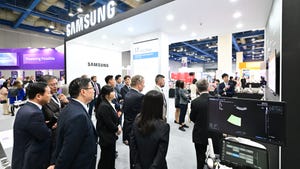Ocular Sees a Single Fabric
Metropolitan optical player plans a single switching fabric for multiple voice and data traffic types
October 30, 2000

Not much has been heard from Ocular Networks Inc. in the last few months, since it closed its first round of $20 million. But today the company is releasing details about its multiservice access switch (see Ocular Networks Inc.).
The vendor claims a "protocol agnostic" switch fabric will offer a cheaper and more flexible way for carriers to offer both data and voice services to end users.
This is not an unfamiliar claim. At least a dozen other vendors say they can also lower costs and ease provisioning (see Automate or Suffocate ). But Ocular says its architecture will allow bandwidth to be provisioned in more granular increments, making it more attractive for the access network.
“They can go to a much smaller scale than some of the other provisioning platforms,” says Scott Clavenna, president of PointEast Research and director of research for Light Reading. “Its smaller form factor and single switching fabric makes it really cost effective, too.”
Ocular's approach differs from next-generation Sonet TDM (time-division multiplexing) devices like those from Cisco Systems Inc. (Nasdaq: CSCO) (through the Cerent acquisition) and Fujitsu Ltd. (KLS: FUJI.KL). The Ocular switch will be geared more toward data. When data traffic surpasses voice traffic, the Sonet approach becomes more costly, claims Doug Green, VP of marketing for Ocular.
Green also says Ocular's products will differ from the products of those vendors that have taken a hybrid approach, such as Mayan Networks Inc. and Lucent Technologies Inc. (NYSE: LU) (through its acquisition of Chromatis). Such products allow IP, ATM, and TDM traffic to be switched in its native form. This is more efficient than the multilayer switch approach, says Green. But each traffic type needs its own switch fabric. When carriers want to add new traffic types, they have to add additional fabrics, which take up valuable input/output (IO) slots.
“The key is that it doesn’t waste IO slots by adding switch fabrics,” says Alex Benick, an analyst at the The Yankee Group, of Ocular's planned product. “That’s really important; that’s how these carriers make money.”
Ocular’s proposed architecture takes the multilayer switch architecture a step further, adds Benick. Instead of multiple switch fabrics, it has a single fabric that is able to switch IP, ATM, and TDM natively.
“When you have one fabric you can provision through software,” says Clavenna. “This is great for the access market. The last thing they want to do is send out people everytime a box needs to be configured.”
The company is expecting to close a second round of funding in the next three to six months. Its previous round included investments from Bessemer Ventures, Columbia Capital, and Highland Capital Partners. Products are expected to go into beta tests by the end of the year and will be shipping to customers in early 2001, says the vendor.
-- Marguerite Reardon, senior editor, Light Reading, http://www.lightreading.com
You May Also Like










